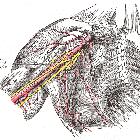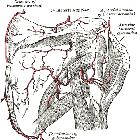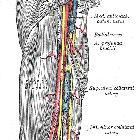axillary artery



The axillary artery represents the continuation of the subclavian artery and is a major artery of the upper limb.
Summary
- origin: continuation of the subclavian artery as it passes under the midpoint of the clavicle on the outer edge of the first rib
- termination: continues as the brachial artery at the lower border of teres major
Gross anatomy
The axillary artery enters the axilla by passing behind the midpoint of the clavicle on the outer edge of the first rib. The axillary artery is divided into three parts by its relation to pectoralis minor muscle:
- the first part is proximal to pectoralis minor
- the second part is posterior to pectoralis minor
- the third part is distal to pectoralis minor
A useful mnemonic to remember its branches can be found here. The axillary vein is anterior to the artery .
First (suprapectoral) part
The first part of the axillary artery has one branch:
- superior thoracic artery: runs anteriorly to supply pectoralis major and minor
Second (retropectoral) part
The second part of the axillary artery has two branches:
- thoracoacromial artery: runs over pectoralis minor to pierce the clavipectoral fascia and supply the clavicle, deltoid, acromion and pectoralis muscles via its four terminal branches
- lateral thoracic artery: runs laterally along the lower border of pectoralis minor to supply serratus anterior and both pectoralis muscles, also an important blood supply to the breast in the female
Third (infrapectoral) part
The third part of the axillary artery has three branches:
- subscapular artery: the largest branch of the axillary artery, travels along the posterior wall of the axilla; distally, it divides into the thoracodorsal artery, giving branches to serratus anterior, and into the circumflex scapular artery which contributes to the scapular anastomosis; thoracodorsal artery then runs with the thoracodorsal nerve from the posterior cord to enter and supply the anterior edge of latissimus dorsi
- anterior humeral circumflex artery: gives an ascending branch as an important supply to the head of the humerus, then passes around the surgical neck of the humerus and anastomoses with the posterior circumflex artery
- posterior humeral circumflex artery: passes through the posterior wall of the axilla with the axillary nerve to supply deltoid; it also supplies triceps brachii and glenohumeral joint
Relations
The cords of the brachial plexus are closely related to the axillary artery :
- at the first part of the axillary artery, the lateral and posterior cords lie superolateral, whereas the medial cord lies posteriorly; a loop connecting the medial and lateral pectoral nerves also lies anterior to the axillary artery
- at the second part of the axillary artery, the posterior, lateral and medial cords embrace the artery as per their names
- at the third part of the axillary, the cords then branch into their respective peripheral nerves
Variant anatomy
Branches from the axillary artery are highly variable. In one study, variations of the subscapular artery and posterior circumflex humeral artery were noted in ~65% of the cases, and could be grouped into five main categories:
- high origin of the subscapular artery from the second part of the axillary artery
- common trunk for subscapular artery and posterior circumflex humeral artery from the second part of the axillary artery
- common trunk for subscapular artery and posterior circumflex humeral artery from the third part of the axillary artery
- common trunk for subscapular artery and posterior circumflex humeral artery with the thoracodorsal artery originating directly from the axillary artery
- common trunk for subscapular artery, posterior circumflex humeral artery and deep brachial artery
- anomalous high division into radial and ulnar arteries
- absence of lateral thoracic artery (replaced by lateral perforating branches of the intercostal arteries)
- alar thoracic artery: supplies the fat, skin and lymph nodes of the axilla
The thoracoacromial artery, though, appeared to originate from the first or second part of the axillary artery in all cases .
Siehe auch:
- Arteria brachialis
- thoracoacromial artery
- Arteria subclavia
- Arteria thoracica lateralis
- Arteria circumflexa humeri anterior
- Arteria thoracica superior
- Arteria subscapularis
- Arteria circumflexa scapulae
- Arteria thoracodorsalis
- Arteria circumflexa humeri posterior
und weiter:

 Assoziationen und Differentialdiagnosen zu Arteria axillaris:
Assoziationen und Differentialdiagnosen zu Arteria axillaris:


